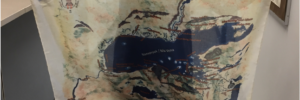Google.org has announced a $5 million grant and Fellowship to Woodwell Climate Research Center for the expansion of the Permafrost Discovery Gateway. This initiative will revolutionize the accessibility of valuable information on changing permafrost conditions across the Arctic, and enable real-time tracking of permafrost thawing by using satellite imagery and artificial intelligence (AI) technologies. The… Read more »
Blog & News Items
Arctic Data Center: AGU 2022 Reflections
By Ranna Zahabi The Arctic Data Center enjoyed its time at the American Geophysical Union conference this year. AGU 2022 was a new experience for many on our team, and the new Chicago location had us embracing the cold. Although the conference is traditionally held in San Francisco, the change in scenery this year came… Read more »
Sea Ice Research and Arctic Data: A Conversation with Angela Bliss

By Ranna Zahabi, Natasha Haycock-Chavez, Daphne Virlar-Knight, and Matt Jones Angela Bliss is a research scientist at the Cryospheric Sciences Laboratory of NASA’s Goddard Space Flight Center in Greenbelt, MD. Bliss’s Arctic Research based around the MOSAiC expedition is fascinating, considering the unique approaches to her research regarding the breadth of data available. Her work… Read more »
Applying CARE: Documenting Ethical Data Procedures and Sensitive Data at the Arctic Data Center

By Natasha Haycock-Chavez, Amber Budden and Matt Jones At its foundation, open-science is based on making all aspects of scientific research accessible across broad communities, whether professional, academic, or public. This includes publications, data, software, samples, and code, and at its core, open science is built on principles of transparency and capacity for collective knowledge…. Read more »
A diverse Science Advisory Board in service of the Arctic Data Center community

Renewed funding, renewed focus and renewed partnerships; the Arctic Data Center seeks nominations for the 2021-2024 Science Advisory Board. The NSF Arctic Data Center Science Advisory Board comprises 10 members who provide advice and leadership to the Center regarding goals and strategic priorities in support of the Arctic research and education community. Through engagement and… Read more »
Understanding the Arctic

Sustaining the Arctic Data Center enables research advances by using open data The National Science Foundation (NSF) has reaffirmed its commitment to data archiving and sharing in the Arctic by investing $6 million to continue funding of the Arctic Data Center for another five years. This partnership, led by the National Center for Ecological Analysis and Synthesis (NCEAS)… Read more »
Documenting Yup’ik Place Names with Dr. Yoko Kugo

Dr. Yoko Kugo’s dataset – Iliamna Lake (Nanvarpak, Nila Vena) Native and Local Place Names (2016-2019) – compiled the local place names in and around Iliamna Lake in Alaska with the help of five specific communities: Iliamna, Newhalen, Kokhanok, Igiugig, and Levelock. Check out the dataset and learn more about the importance and applications of this data in our Q&A with Dr. Kugo.
Arctica: The Arctic Data Center Newsletter, Volume 2

This blog post is the published version of Arctica, Volume 2, which was sent out to email subscribers on 9 March 2021.
Engage with the Arctic Data Center at AGU 2020

Arctic Data Center staff will be convening the following sessions and giving the following talks at AGU 2020.
Hands-on Coding . . . Virtually?

Understanding the Arctic Data Center’s approach to learning data science and management and how we transitioned it online.
